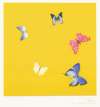Love
In his Love prints, Damien Hirst pastes butterflies inside bold heart icons. Hirst once stated that his butterflies are intended to look as though they have accidentally got ‘stuck’ in the drying paint. For Hirst, the delicacy of butterflies prompts an ambiguous exploration of life’s fragility.
Damien Hirst Love For sale
Love Value (5 Years)
Works from the Love series by Damien Hirst have a strong market value presence, with 50 auction appearances. Top performing works have achieved standout auction results, with peak hammer prices of £70000. Over the past 12 months, average values across the series have ranged from £20000 to £70000. The series shows an average annual growth rate of 5.68%.
Love Market value
Auction Results
| Artwork | Auction Date | Auction House | Return to Seller | Hammer Price | Buyer Paid |
|---|---|---|---|---|---|
 Love Is All You Need Damien Hirst Signed Print | 25 Oct 2024 | Phillips London | £18,700 | £22,000 | £30,000 |
 All You Need Is Love Love Love Damien Hirst Signed Print | 25 Oct 2024 | Phillips London | £16,150 | £19,000 | £25,000 |
 All You Need Is Love Love Love (diamond dust) Damien Hirst Signed Print | 17 Sept 2024 | Christie's London | £20,400 | £24,000 | £35,000 |
 Big Love Damien Hirst Signed Print | 6 Jun 2024 | Phillips London | £29,750 | £35,000 | £50,000 |
Sell Your Art
with Us
with Us
Join Our Network of Collectors. Buy, Sell and Track Demand
Meaning & Analysis
A firmly established motif in Hirst’s work, the butterfly dominates his love series, here appearing to flutter against bold heart-shaped backdrops. Each print shows an array of butterflies inside a visually simplified and bold heart shape. Every butterfly in each square composition is unique and is rendered in bright, contrasting colours to stand out against their plain white backdrops.
Reminiscent of his series of paintings entitled The Four Elements (Who’s Afraid of Red, Yellow, Green and Blue) from 2005, the screen prints in the Love series show the butterflies as though trapped on fly-paper. Works such as this were intended to ‘look like an accident of paint with butterflies stuck on it,’ according to the artist. The butterfly is among Hirst’s most famous motifs, emblematic of the fleetingness of life and the romance of death. Hirst’s long-standing obsession with the butterfly motif was conceived in the late 1980s, when he saw flies become stuck on primed canvases whilst he was working on the fly and cow’s head sculpture A Thousand Years from 1990.
The Love series takes the optimistic sentiments of the Beatles for the prints’ titles like All You Need Is Love Love Love and fuses this with Hirst’s subtle reflections on mortality. The butterflies appear to be suspended in celebration, their wings retaining their vibrance even in death. Hirst uses the butterfly motif throughout his artistic oeuvre as a ‘universal trigger.’ This motif helps the artist to explore the uncertainties at the core of human experience: love, life, death, loyalty and betrayal through unconventional media.















